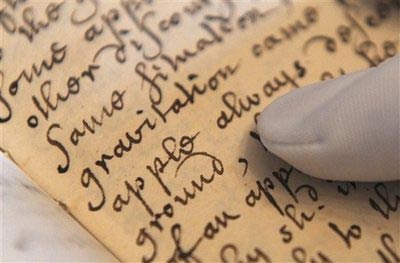|
 In this photo taken Friday, January 15, 2010, Royal Society librarian Keith Moore holds the manuscript of 'Memoirs of Sir Isaac Newton' by William Stukeley, pointing to the word 'gravitation', in London. An 18th-century account of how a falling piece of fruit helped Isaac Newton develop the theory of gravity is being posted to the Web on Monday, Jan. 18, 2010, making scans of the fragile paper manuscript widely available to the public for the first time.(Agencies) |
| It always falls down. That's how the apple helped Isaac Newton.
An 18th-century account of how Newton developed the theory of gravity was posted to the Web Monday, making the fragile paper manuscript widely available to the public for the first time. Newton's encounter with the apple ranks among science's most celebrated anecdotes, and it can now be read in the faded cursive script in which it was recorded by William Stukeley, Newton's contemporary. Royal Society librarian Keith Moore said the apple story has resonated for centuries because it packs in so much — an illustration of how modern science works, an implicit reference to the solar system and even an allusion to the Bible. When Newton describes the process of observing a falling apple and guessing at the principle behind it "he's talking about the scientific method," Moore said. "Also the shape of the apple recalls the planet — it's round — and of course the apple falling from the tree does indeed hark back to the story of Adam and Eve, and Newton as a religious man would have found that quite apt." The incident occurred in the mid-1660s, when Newton retreated to his family home in northern England after an outbreak of the plague closed the University of Cambridge, where he had been studying. Stukeley's manuscript recounts a spring afternoon in 1726 when the famous scientist shared the story over tea "under the shade of some apple trees." Stukeley wrote that Newton told him the notion of gravity popped into the scientist's mind as he was sitting in the same situation. "It was occasion'd by the fall of an apple, as he sat in contemplative mood. Why should that apple always descend perpendicularly to the ground, thought he to himself ... Why should it not go sideways, or upwards? But constantly to the earth's center?" Stukeley wrote. "Assuredly, the reason is, that the earth draws it. There must be a drawing power in matter." Stukeley's account on the Royal Society's Web site joins notes from Newton's 17th-century scientific rival Robert Hooke — documents that were lost for several hundred years before their recent discovery in a house in England. (Read by Renee Haines. Renee Haines is a multimedia journalist at the China Daily Web site.) 点击查看更多双语新闻
|
它总是垂直下落——苹果正是这样启发了艾萨克•牛顿。 本周一,一份有关牛顿是如何发现万有引力定律的18世纪的手稿被传到网上,让不易保存的纸质手稿内容首次在网上与公众见面。 牛顿与苹果的故事是最著名的科学轶事之一,现在这个故事竟可以在褪了色的手写稿中读到,这份手稿的内容是由与牛顿同时代的(科学家)威廉•斯蒂克利记录的。 摩尔说,当牛顿描述观察苹果落地的过程并猜想其背后的原理时,“他说的是科学方法”。 (中国日报网英语点津 陈丹妮 编辑蔡姗姗) |
|
Vocabulary: cursive:Having the successive letters joined together: 草书的:连续的字母连在一起的 hark back to: to remind you of, or to be like, something in the past 使想起 retreat: to escape to a place that is quieter or safer 隐退 perpendicularly: in a perpendicular manner 垂直地 |
